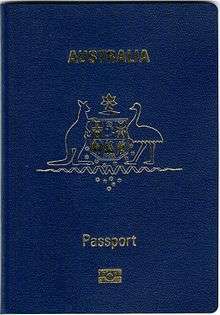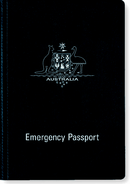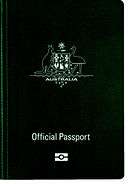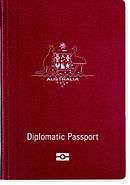Australian passport
| Australian passport | |
|---|---|
 The front cover of a contemporary Australian ePassport (with chip | |
| Date first issued |
24 October 2005 (biometric passport) June 2014 (current version) |
| Issued by |
|
| Type of document | Passport |
| Purpose | Identification |
| Eligibility requirements | Australian citizens |
| Expiration |
10 years after issuance for adults and children aged 16+ 10 or 5 years for adults aged 75 and over 5 years for children until the age of 16 |
| Cost |
Adult: Ordinary: A$254 Frequent traveller: A$382 Aged 75 or over (5 year passport): A$127 Child: Under age of 16: A$127 Aged 16 or 17: A$254 [1][2] |
Australian passports are travel documents issued to Australian citizens under Australian Passports Act 2005 by the Australian Passport Office of the Department of Foreign Affairs and Trade, both in Australia and overseas, which enable the passport bearer to travel internationally. Australian citizens are allowed to hold passports from other countries,[3]
The 100 point check personal identification system applies to new applicants for an Australian passport,[4] and an Australian passport can in turn be used as an identification document of the passport holder (worth 70 points in the 100 point check scheme). The scheme's requirements do not apply to a renewal of a passport.
Since 24 October 2005 Australia has issued only biometric passports, called ePassports, which have an embedded microchip that contains the same personal information that is on the color photo page of the passport, including a digitized photograph. SmartGates have been installed in Australian airports to allow Australian ePassport holders and ePassport holders of several other countries to clear immigration controls more rapidly, and facial recognition technology has been installed at immigration gates.[5]
History
Before 1901, Australia consisted of six separate British colonies. Passports usage was not common, and if required British or other national passports were used. In 1901, the six colonies joined to form the Commonwealth of Australia, but Australian passports did not exist. During World War I, the monitoring and identifying of those crossing international borders was regarded as critical to the security of Australia and its allies, and the War Precautions Act 1914 required all persons over 16 years of age, on leaving Australia, to possess some passport.[6] Passports issued by Australia were issued only to "British subjects" and were described as "British Passports".
Australian nationality came into existence on 26 January 1949 when the Nationality and Citizenship Act 1948 came into force, and the words British Passport on the cover of Australian passports were replaced by Australian Passport. British subjects, who were not Australian citizens, continued to be entitled to an Australian passport. The term "British subject" had a particular meaning in Australian nationality law. The term encompassed all citizens of countries included in the list contained in the Australian Citizenship Act 1948. The list of countries was based on, but was not identical with, those countries (and their colonies) which were members of the Commonwealth from time to time. The list was amended from time to time as various former colonies became independent countries, but the list in the Act was not necessarily up-to-date as far as to constitute exactly a list of countries in the Commonwealth at any given time. This definition of "British subject" meant that, for the purposes of Australian nationality law, citizens of countries which had become republics, such as India, were classified as "British subjects". This legal category was abolished in 1984 by the Australian Citizenship Amendment Act 1984, and Australian passports began to be issued exclusively to Australian citizens,[7] though existing passports held by non-citizens continued to be valid until each expired.
Since 24 October 2005, Australia has issued only biometric passports, called ePassports, which have an embedded RFID microchip that contains the same personal information that is on the color photo page of the passport, including a digitized photograph. SmartGates have been installed in Australian airports to allow Australian ePassport holders, and ePassport holders of several other countries, to clear immigration controls more rapidly, and facial recognition technology has been installed at immigration gates.[5]
- In 1917, 'X' series passports issued.
- In 1949, after Australian nationality was created, the words Australian Passport replaced British Passport on the cover of Australian passports.[6] Two types of passport were issued:[6]
- 'B' series passports — issued (within Australia only) to British subjects who were not Australian citizens.
- 'C' series passports — issued to Australian citizens.
- In 1950, ‘E’ series passport replaces ‘B’ and ‘C’ series.[8]
- In 1964, ‘G’ series passport introduced, with the St Edward's Crown at the top of the cover, the word ‘Australia’ followed by the Australian Coat of Arms, and the words ‘British Passport’ at the bottom.[8]
- In 1967, the word ‘British Passport’ was removed from passports but retain the Crown. The word ‘Australia’ appears below the Crown, followed by the Australian Coat of Arms and the word ‘Passport’.[8]
- In 1975, Responsibility for Australian passport functions transferred to the Department of Foreign Affairs (now the Department of Foreign Affairs and Trade), from the then Department of Labour and Immigration.[8]
- In 1980, Computerised Passport Issue and Control System (PICS) launched.[8]
- Before 1983, a married woman's passport application had to be authorised by her husband.[6]
- In 1983, the Department partnered with Australia Post to allow the issuance of Australian passports at most Australia Post outlets.[6]
- In 1984, ‘T’ series passport introduced, with Crown emblem removed from cover.[8] And machine readable lines and were the first to have a laminate built into the document.[6]
- In 1986, the introduction of Single Identity passports meant children could no longer be included on their parent's passport.[6]
- In 1988, ‘H’ and ‘J’ series passports issued with Bicentennial logo. And until 1988, a woman could apply for and receive a passport in her married name, before she was actually married.[6]
- In 1994, Digitised colour printing of photograph and signature on the glue side of the laminate introduced.[8]
- In 1995, ‘L’ series passports introduced, with kangaroo motif security laminate. The personal data pages initially included a photograph and a cut out piece of paper with the holders signature under a sheet of adhesive laminate.[8]
- From approximately 1998, the personal data page for 'L' series passports was colour laser printed and under a sheet of adhesive laminate
- The 'M' series passport was issued from 27 November 2003, which included enhanced security features. The personal data page of these passports is printed by ink-jet onto the adhesive surface of the security laminate, the laminate itself containing a holographic design.
- From October 2005, the 'M' series was issued as a biometric or e-passport. An electronic passport logo was printed under the passport number on the personal data page. The front cover was printed in gold ink.
- Since May 2009 the 'N' series has been issued as a biometric or e-passport. The passport is black instead of blue and has a slight font and case change to the word 'Passport' on the front cover. The front cover printing is now in silver. Additional fraud counter-measures have been included in the passport including a 'Ghost Image' and 'Retro-Reflective Floating Image' on the laminated page. Each page features images of Australia printed throughout the document making every visa page unique and more difficult to reproduce.[9]
- In late June 2014, the "'P' series" have been issued with innovative security features that make it even more difficult to forge. Australian-flag blue with gold embossed cover, the 'P' series passport builds on the already advanced features of the e-Passport. The 'P' series is printed using the same technologies as Australian banknote. Visible security features include a new security laminate with the world’s first colour floating image.[10]
Types of passports



- Standard Passport (Blue or Black Cover) – Issued for ordinary travel, such as vacations and business trips, it has 34 visa pages (42 pages overall) with 10 years validity.
- Frequent Traveler Passport – Issued to frequent travelers, such as business people (66 visa pages).
- Child's Passport – Issued to Australian citizens aged under 18 years, for half the cost of a standard passport, it has 34 visa pages with 5 years validity.. Children 16 and over, are issued with 10 year validity passport.
- Emergency Passport - Issued to Australian citizens that urgently need to travel on short notice or urgently need to replace their lost or stolen passport. Emergency passports are issued with a maximum 12 months validity.
- Official Passport (Grey-asparagus Cover) – Issued to individuals representing the Australian government on official business. (42 pages)
- Diplomatic Passport (Red Cover) – Issued to Australian diplomats, top ranking government officials and diplomatic couriers. (42 pages)
The embedded chip stores the owner's digitised photograph, name, gender, date of birth, nationality, passport number, and the passport expiry date. This is the same information that appears on the printed information page of every passport. Facial recognition technology was introduced with the release of the ePassport to improve identity verification and reduce identity-related fraud.
Physical appearance
The current 'P' series Australian passports are Australian-flag blue, with the Australian coat of arms emblazoned in gold in the centre of the front cover. The word "Passport" and the international e-passport symbol (![]() ) are inscribed below the coat of arms, and "AUSTRALIA" above. The standard passport contains 42 (pps 17 & 18 unusable as they contain the contactless IC) visa pages, but it can be issued in a 74-page format upon request for an additional fee.
) are inscribed below the coat of arms, and "AUSTRALIA" above. The standard passport contains 42 (pps 17 & 18 unusable as they contain the contactless IC) visa pages, but it can be issued in a 74-page format upon request for an additional fee.
Identity Information Page

The Australian passport includes the following data:
- Photo of passport owner
- Type (P for passport)
- Code of Issuing State (AUS)
- Document No.
- Name
- Nationality (Australian)
- Date of Birth
- Sex (male, female and indeterminate). First reported in 2003 with recipient Alex MacFarlane, intersex people with "indeterminate" birth certificates could choose 'X'.[11][12][13] In 2011, this was extended to permit intersex and trans people to choose this when supported by a doctor's statement. Individuals may report their identified gender without having had surgical intervention.[14][15]
- Place of birth (Only the city or town is listed, even if born outside Australia)
- Date of issue
- Owner's signature
- Date of expiry
- Authority (Australia if issued in Australia, or the name of the issuing diplomatic mission if issued overseas – e.g. London[16])
The information page ends with the Machine Readable Zone.
Passport note
The passports contain a note from the issuing state that is addressed to the authorities of all other states, identifying the bearer as a citizen of that state and requesting that he or she be allowed to pass and be treated according to international norms. The note inside Australian passports states:
- The Governor-General of the Commonwealth of Australia, being the representative in Australia of Her Majesty Queen Elizabeth the Second, requests all those whom it may concern to allow the bearer, an Australian Citizen, to pass freely without let or hindrance and to afford him or her every assistance and protection of which he or she may stand in need.
Languages
The passport is printed in English. French translation is found on the identity information, observations, chip centre and notice pages.
Features
- Microprinting – for example, horizontal lines on the notice/bearer's information pages are made up of microprinted words.
- In L-series passports, the first verse of Advance Australia Fair is used.
- In M-series passports, the words are from Waltzing Matilda.
- In N-series passports, the lines are made up of the word "Australia" repeated.
- N-series passports also feature microprinted words from Clancy of the Overflow on the visa pages.
- The laminate of the identity information page on M-series and later passports contains retro-reflective floating images of kangaroos.
Renewal
Australian citizens, aged 18 years or over who have an adult Australian passport that was valid for at least two years when issued, and was issued on or after 1 July 2000, in the current name, date of birth and sex or have a child Australian passport that was valid for at least two years when issued, and was issued on or after 1 July 2005, and that were 16 years or over at the time of issue may apply online for a renewal. If overseas, this may be done by contacting the nearest Australian diplomatic mission.
Renewals are not available for lost or stolen passports, in which case an application for a new passport must be made.
Refusal to issue passport
Under the Australian Passports Act 2005, the Minister for Foreign Affairs has the power to refuse, cancel or suspend a passport on a number of grounds including national security or health.[17]
Visa requirements
An Australian passport does not, in itself, entitle the holder to enter another country. To enter another country, the traveller must comply with the visa and entry requirements of the other countries to be visited, which vary from country to country and may apply specifically to a particular passport type, the traveller's nationality, criminal history or many other factors.
According to the 2016 Visa Restrictions Index, Australian passport holders can visit 169 countries visa-free or with visa on arrival.
Foreign travel statistics
According to the statistics these are the numbers of Australian visitors to various countries per annum in 2015 (unless otherwise noted):
Declared area offence
Australian law makes it an offence for Australians to enter, or remain in, certain regions designated as 'declared areas'.[113] The Government may declare an area (but not a whole country) if it considers terrorists are operating in that area. The maximum penalty is 10 years imprisonment, however it is a defence if a person can show they entered or remained for legitimate purposes prescribed in regulations. As at June 2015 declared areas include:
- Mosul district, Ninewa province in Iraq
- Al-Raqqa province in Syria
See also
- Australian Certificate of Identity
- Australian nationality law
- Biometric passport
- Visa requirements for Australian citizens
External links
| Wikimedia Commons has media related to Passports of Australia. |
- Gateway to the IATA Timatic Web database from Qantas website
- Department of Foreign Affairs and Trade (DFAT): Australian Passports website
- smarttraveller.gov.au – travel advisories and bulletins provided by DFAT including:
- Portrait of an Australian – a virtual artists' book in the form of an Australian passport created by Jonathan Tse; digitised and held by the Australian Library of Art, State Library of Queensland[114]
- https://web.archive.org/web/20060805203832/http://www.silicon.com:80/publicsector/0,3800010403,39161215,00.htm
- A Passport Identifies who a Person Is
- Australian Passport Office Apologises to Stephanie Imbruglia
References
Citations
- ↑ "Passport Fees". Retrieved January 1, 2016.
- ↑ "Child Passport Guide". Retrieved January 1, 2016.
- ↑
- ↑ Documents that confirm your Australian citizenship and identity
- 1 2 "SmartGate Frequently Asked Questions – What is an Australian ePassport?". Australian Customs Service.
- 1 2 3 4 5 6 7 8 Passports.gov.au Passport History
- ↑ Stephen Smith (28 May 2009). "Speech: Launch of the N Series Passport". Retrieved 2010-01-14.
- 1 2 3 4 5 6 7 8 "The evolution of the Australian passport". Australian Government. 15 Jul 2013. Archived from the original on 1 June 2011.
- ↑ "New 'N Series' Australian Passport". Australian Government. 28 May 2009.
- ↑ "New generation of Australian passports released". Department of Foreign Affairs and Trade (Australia). 25 June 2014.
- ↑ Ingrid Holme, "Hearing People's Own Stories", in Science as Culture, Volume 17, Issue 3, 2008
- ↑ "X marks the spot for intersex Alex" Archived 10 November 2013 at the Wayback Machine., West Australian, via bodieslikeours.org. 11 January 2003
- ↑ "Neither man nor woman", Sydney Morning Herald. 27 June 2010
- ↑ "Australian Government Guidelines on the Recognition of Sex and Gender"
- ↑ McGuirk, Rod (15 September 2011). "Male, female or 'X'? Third gender choice for Australian passports". The Star. Toronto.
- ↑ Down Under Photography. "New N Series Australian Passport". Flickr. Retrieved 2010-01-14.
- ↑ Australian Passports Act 2005
- ↑ Statistical Yearbook 2014 pages 91-92
- ↑ Tourismus in Österreich 2015
- ↑ Number of foreign citizens arrived to Azerbaijan by countries
- ↑ Stopovers by Country, table 34
- ↑
- ↑ "Arrivals of informational visitors by country of residence".
- ↑ "Agencija za statistiku BiH" (PDF). Retrieved 23 February 2016.
- ↑ Tourism Statistics Annual Report 2014
- ↑
- ↑ Brunei Darussalam Tourism Report 2011
- ↑ http://www.tourismcambodia.org/images/mot/statistic_reports/tourism_statistics_2015.pdf
- ↑ Service bulletin International Travel: Advance Information, December 2015
- ↑ Air Visitor Arrivals - Origin & General Evolution Analysis
- ↑
- ↑
- ↑
- ↑
- ↑ TOURIST ARRIVALS AND NIGHTS IN 2015
- ↑ ARRIVALS OF TOURISTS BY COUNTRY OF USUAL RESIDENCE
- ↑ Estadisticas Turisticas 2015 pages 47-48
- ↑
- ↑
- ↑ VISITOR ARRIVALS - NUMBER BY COUNTRY OF RESIDENCE, Fiji Bureau of Statistics
- ↑
- ↑ Nombre de touristas
- ↑ Tourismus in Zahlen 2015, Statistisches Bundesamt
- ↑
- ↑
- ↑ Visitor arrival statistics. Origin of air arrivals
- ↑ 2015 Visitor Arrivals Statistics
- ↑ Tourism in Hungary 2015
- ↑ "Jumlah Kedatangan Wisatawan Mancanegara ke Indonesia Menurut Negara Tempat Tinggal 2002–2013" (in Indonesian). Statistics Indonesia (Badan Pusat Statistik). Retrieved 25 August 2015.
- ↑
- ↑ VISITOR ARRIVALS(1), BY COUNTRY OF CITIZENSHIP, Central Bureau of Statistics
- ↑ IAGGIATORI STRANIERI NUMERO DI VIAGGIATORI
- ↑
- ↑ - 2015 Foreign Visitors & Japanese Departures, Japan National Tourism Organization
- ↑
- ↑ Visitor Arrivals by Country of Residence - Tarawa only
- ↑ Tourism in Kyrgyzstan
- ↑
- ↑
- ↑ Number of guests and overnights in Lithuanian accommodation establishments. '000. All markets. 2014-2015
- ↑ Visitor Arrivals
- ↑ Statistical review: Transport, tourism and other services
- ↑ http://mytourismdata.tourism.gov.my/?page_id=232#!range=year&from=2014&to=2015&type=55876201563fe,558762c48155c&destination=34MY&origin=51AU,51NZ
- ↑ Number of visitors by country, 2009
- ↑ http://www.tourism.gov.mv/download/december-2015-update/
- ↑ Tourist arrivals by country of residence
- ↑ Visitantes internacionales por vía aérea por principal nacionalidad
- ↑
- ↑ "Statistics of Tourists to Mongolia".
- ↑ Table 4. Foreign tourist arrivals and overnight stays by countries, 2014
- ↑ "Myanmar Tourism Statistics 2015" (PDF). Central Statistical Organization. Ministry of National Planning and Economic Development. Retrieved 5 January 2016.
- ↑
- ↑ Nepal Tourism Statistics 2015
- ↑ Inbound tourism 2014
- ↑
- ↑ Statistics of New Zealand. Visitor arrivals by country of residence. Australia.
- ↑ "Visitors arrival by country of residence and year".
- ↑ Number of Tourists to Oman
- ↑ Pakistan Statistical Year Book 2012 20.31
- ↑
- ↑
- ↑
- ↑ The data obtained on request. Ministerio de Comercio Exterior y Turismo
- ↑
- ↑
- ↑ http://www.russiatourism.ru/contents/statistika/statisticheskie-pokazateli-vzaimnykh-poezdok-grazhdan-rossiyskoy-federatsii-i-grazhdan-inostrannykh-gosudarstv/strany-lidiruyushchie-po-kolichestvu-pribytiy-na-territoriyu-rossiyskoy-federatsii/
- ↑
- ↑ Tourist turnover in the Republic of Serbia - December 2015
- ↑
- ↑ "International Visitor Arrivals". Singapore Tourism Board. Retrieved May 22, 2016.
- ↑ Slovenian Tourism in Numbers 2015
- ↑ statistics/visitor-arrivals
- ↑
- ↑
- ↑ TOURIST ARRIVALS BY COUNTRY OF RESIDENCE 2015
- ↑ Tourist Arrivals By Country Of Residence 2015
- ↑ Swaziland Tourism Statistics 2015 - Arrivals by country
- ↑ "Tourism Bureau, M.O.T.C. Republic of China (Taiwan) Visitor Arrivals by Residence, 2015". admin.taiwan.net.tw. Retrieved 2015-05-28.
- ↑
- ↑
- ↑ Ministry of Tourism and Sports,Thailand International Tourist Arrivals to Thailand By Nationality January - December 2015
- ↑
- ↑ Border Statistics 2015
- ↑ Migration - Visitors by nationalities
- ↑ MINISTRY OF TOURISM, WILDLIFE AND ANTIQUITIES SECTOR STATISTICAL ABSTRACT,2014
- ↑ Foreign citizens who visited Ukraine in 2015 year, by countries
- ↑ 2.10 Number of visits to UK: by country of residence 2011 to 2015
- ↑ 2014 Yearbook of Immigration Statistics
- ↑
- ↑ International visitors to Viet Nam in December and 12 months of 2015
- ↑
- ↑ Tourism Trends and Statistics Annual Report 2014
- ↑ "Declared area offence". Australian National Security. Australian Government. Retrieved 25 June 2015.
- ↑ Barrett, Rosanne (1 November 2009). "Long-distance call". South China Morning Post. Retrieved 14 July 2014.
Sources
- http://www.dfat.gov.au/dept/passports/ - Outdated, see this one instead: http://www.passports.gov.au/
- http://www.dfat.gov.au/publications/passports/Policy/TravelDocuments/index.htm
- http://www.foreignminister.gov.au/releases/2005/fa132_05.html
- http://www.foreignminister.gov.au/releases/2006/fa045_06.html
- http://www.stlucia.gov.lc/faq/do_i_need_a_visa_to_enter_saint_lucia.htm#Do_Not_Require_Visas
